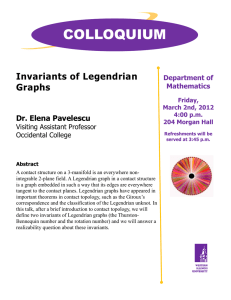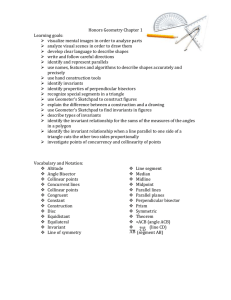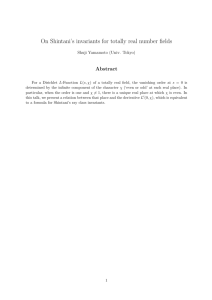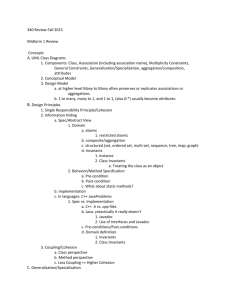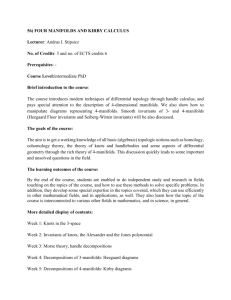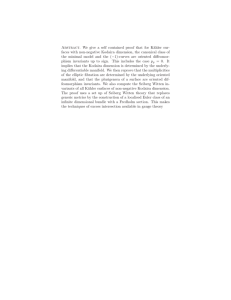Invariants and Differential Operators William Traves U.S. Naval Academy
advertisement
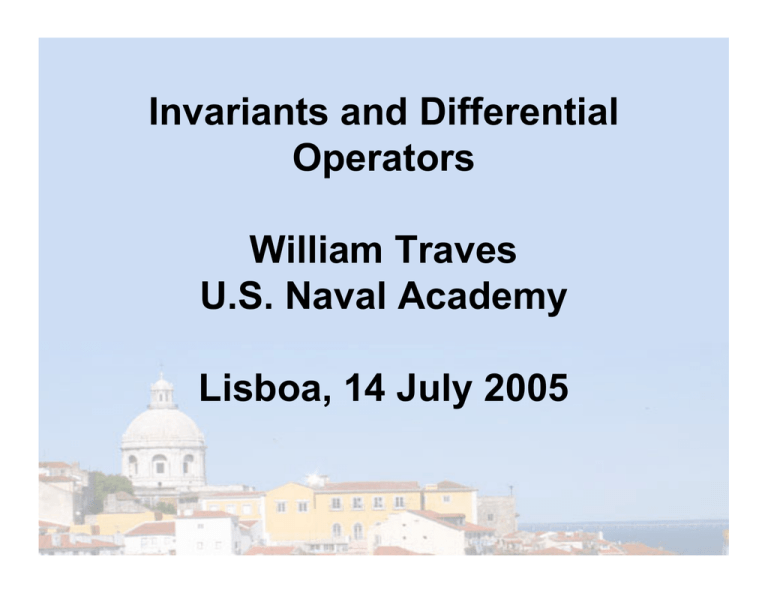
Invariants and Differential
Operators
William Traves
U.S. Naval Academy
Lisboa, 14 July 2005
Agenda
• Invariant Theory
• Group actions
• Rings of invariants
• Reynolds operator
• New invariants from old
• Differential conditions
• The symmetry algebra and D(RG)
• Computing D(RG)
• Properties of D(RG)
Group Actions
When a group G acts on a set X we can
consider the orbit space X/G.
We’ll focus on the case where we have a
linear representation of G: X ≅ kn.
Example: If G = <σ: σ2 = e > acts on the line
X = R by σ(x) = -x then X/G is a half-line.
Examples of G-actions
Example: G = C* acts on X = C2 \{(0,0)} by
dilation
t(x,y) = (tx, ty).
The orbits are the punctured lines through
the origin and X/G is just the projective space
P1C.
Unhappy G-actions
Modify the last example a little: let G = C*
act on X = C2 via dilation t(x,y) = (tx, ty).
The orbits are: • the origin itself
• punctured lines through the origin
X/G is not an algebraic variety!
Therapy for unhappy G-actions
• Surgery: Remove the offending orbits
from the original space
• work only with the semistable orbits
• used in G.I.T. to construct moduli spaces
• Less invasive: work with an algebraic version
of the orbit space, the categorical quotient X//G.
Invariants
Invariants are used to define X//G.
The action of G on X induces an action of G on
functions f: X C via (gf)(x) = f(g-1x).
The function f is invariant if gf = f for all g∈G.
It is a relative invariant if
gf = χ(g)f
for some character χ: G C*.
The ring of invariants
The (relative) invariants form a subring
RG of R = C[X].
The categorical quotient X//G is just Spec(RG).
Example: categorical quotient
If G = <σ: σ2 = e > acts on the plane C2 by
σ(x,y) = (-x,-y)
then the orbit space C2 / G is a surface
C[x,y]G = C[x2, xy, y2] (polys of even degree)
Here all orbits are semistable and
C2 / G = C2 // G = Spec C[x2, xy, y2]
In general, X // G = X / G when all the orbits
of G have the same dimension.
Example: binary forms
The space Sd(C2) of degree d forms is
If g ∈ G=Gl2C acts on C2 then g acts on C[x,y]
via the matrix g
Binary forms continued
When we plug into the form
our coefficients change. So we get an induced
action on the coefficients (this is the rep. Sym2(Cd+1))
Let R=C[a0,a1,…,ad] and let RG be the ring of relative
invariants
RG = { f ∈ R: for some w and all g∈G, gf = (det g)w f }
Binary forms continued
There is a correspondence between Gl2C invariants
of weight w and homogeneous Sl2C invariants of
degree 2w/d. Sl2C invariants of binary forms
encode information about the geometry of points
on the projective line.
Example: C[a0,a1,a2]Sl2C= C[a0a2 – a12]
Example: C[a0,a1,a2,a3,a4]Sl2C= C[S,T]
S = a0a4 – 4a1a3 + 3a22 and
T = a0a2a4 – a0a32 + 2a1a2a3 – a12a4 – a32
Elliptic Curves
This last example has to do with elliptic curves.
Every elliptic curve is a double cover of P1,
branched at 4 points.
j(E) = j-invariant of E
= S3/(S3 – 27T2)
Finite Generation
All the rings of invariants we’ve seen so far
have been finitely generated. Gordan proved
that C[X]Sl2C is finitely generated (1868) but
his methods don’t extend to other groups.
King of the invariants
Ring of the invariants
Paul Gordan
G
R
Hilbert’s Finiteness Theorem
Just use the
Reynolds operator!
In 1890 Hilbert shocked the
mathematical community by
announcing that rings of
invariants for linearly
reductive groups are
always finitely generated.
David Hilbert
The Reynolds operator
An algebraic group G is linearly reductive if for
every G-invariant subspace W of a G-vector space
V, the complement of W is G-invariant too:
V = W ⊕ WC.
The Reynolds operator
An algebraic group G is linearly reductive if for
every G-invariant subspace W of a G-vector space
V, the complement of W is G-invariant too:
V = W ⊕ WC.
RG R is a graded map and for each degree
we can decompose Rd = (RG)d ⊕ Td.
As a result, we can split the inclusion by
projecting onto the RG factors.
The Reynolds operator cont.
When G is a finite group, the Reynolds operator
is just an averaging operator
If G is infinite, then can define the Reynolds
operator by integrating over a compact subgroup.
There are also explicit algebraic algorithms to
compute the Reynolds operator in the case of
Sl2C (see Derksen and Kemper’s book).
Hilbert’s wonderful proof
Thm (Hilbert): If G is lin. reductive then RG is f.g.
Proof:
The Hochster-Roberts theorem
Thm (Hochster and Roberts): If G is linearly
reductive, then RG is Cohen-Macaulay.
An elegant proof of the result uses reduction
to prime characteristic and
the theory of tight closure.
Mel Hochster
Computing invariants
Several methods:
(1) Gordan’s symbolic calculus (P. Olver)
(2) Cayley’s omega process
(3) Grobner basis methods (Sturmfels)
(4) Derksen’s algorithm (Derksen and Kemper)
Harm Derksen
Gregor Kemper
Derksen’s Algorithm
(1) It is enough to find generators of the Hilbert
ideal I = RG>0.
(2) These may not generate RG but their images
under the Reynolds operator will.
(3) To find I, we first look at the map
Compute the ideal b by elimination and set y’s
to zero to get generators for the Hilbert ideal.
Agenda
• Invariant Theory
• Group actions
• Rings of invariants
• Reynolds operator
• New invariants from old
• Differential conditions
• The symmetry algebra and D(RG)
• Computing D(RG)
• Properties of D(RG)
New invariants from old
Question (2001): Is the HS-algebra
the same as the Steenrod algebra?
Steenrod algebra ⊂ Weyl algebra
in prime characteristic
Larry Smith
S.A. acts on both C[X] and C[X]G and so it can
be used to produce new invariants from old.
Turns out: SA ≠ HS (INGO 2003).
But the question got me thinking about diff. ops.
and rings of invariants.
Symmetry algebra for HA(β)
Together with M. Saito: Studied the
symmetry algebra for any hypergeo. system HA(β):
The solutions to these systems are connected
to a toric variety and if θ∈SA then θ(f) is a
solution to a new hypergeo. system HA(β’).
Differential conditions
Question: Can we use differential operators
to produce new invariants from known invariants?
Relation between differential equations and
invariants (due to Cayley; see Hilbert, 1897).
We’ll develop these conditions
for the Sl2C invariants of the
binary forms but the basic idea
is that the invariants form a
module over the Weyl algebra.
Arthur Cayley
Torus Invariants
Have a torus T2 sitting in Gl2C as the diagonal
and the invariants f under T2 must satisfy
f(λx,τy)=(λτ)wf(x,y).
Torus Invariants
Have a torus T2 sitting in Gl2C as the diagonal
and the invariants f under T2 must satisfy
f(λx,τy)=(λτ)wf(x,y).
The other two generators
Along with the torus, Gl2C is generated by two
other kinds of matrices
The DE for binary forms
homogeneity
isobaric
if and only if f(a0,a1,…,ad) is a relative
invariant of weight w and degree 2w/d.
Questions on invariant DEs
Question: When is this system holonomic?
In these cases, find a formula (or bounds) for
the holonomic rank of this system.
(Hint: Molien series gives a lower bound)
Symmetry algebra
Given a left ideal J in the Weyl algebra D(R),
the symmetry algebra of J is
Consider the left ideal J in D(R) generated by
the Cayley’s system of differential equations.
What does its symmetry algebra look like?
Symmetry for Cayley’s system
G
G
θ
∈
D(R)
:
θ
•
R
⊂
R
}
⎛ D(R) ⎞ {
G
S⎜
⊂ D(R )
⎟ ≅
G
⎝ J ⎠ {θ ∈ D(R) : θ • R = 0}
New invariants from old
Recall our question: can we use operators to
produce new invariants from old?
The naïve answer is Yes! Just use operators
in D(RG). But this is often badly behaved.
So we’ll try to use its subring S(D(R)/J) instead.
Questions: How do we compute S(D(R)/J) and
what algebraic properties does it have?
When is RG a simple module over S(D(R)/J)?
Invariant operators
If G acts on R then it also acts on the Weyl
algebra D(R): if g•x = Ax then g•∂ = (A-1)T ∂.
The action preserves the order filtration so
it descends to the associated graded ring:
[grD(R)]G = gr(D(R)G).
Since grD(R) is a polynomial ring, its ring of
invariants is f.g. (and so is D(R)G).
Unfortunately, this is not the ring D(RG).
Distinction: D(R)G versus D(RG)
The map RG R induces a map π*: D(R)G D(RG).
We just get π*θ by restriction. Or we can view
the map as:
θ
R
R
R
i
RG
π*θ
RG
Theorem: Im(π*) ⊂ S(D(R)/J) ⊂ D(RG).
Failure of surjectivity
We’ve got a map π*: D(R)G D(RG).
Have Im(π*) ⊂ S(D(R)/J) ⊂ D(RG).
Musson and Van den Bergh showed that the
map π* may not be surjective (G = torus).
Ian Musson
M. Van den Bergh
Surjective when it counts
Schwarz showed that the map π* is surjective
in many cases of interest. In fact, he showed
that the Levasseur-Stafford Alternative holds
for Sl2C representations:
Either (1) RG is regular or
(2) the map π* is surjective
at the graded level
Gerry Schwarz
Computing D(RG)
In most cases the ring RG is not regular and
we have
im π* = S(D(R)/J) = D(RG).
In these cases, we have the analogue of my
result with M. Saito for the HA(β).
We can compute generating sets for these
rings by applying π* to lifts of a generating
set for [grD(R)]G. In particular, for all Sl2C
representations, D(RG) is finitely generated.
Simple Results
For G lin. red, RG is a simple module over D(RG).
D(RG) itself is often a simple ring. For instance,
this is known for tori (Van den Bergh) and for
many classical groups (Levasseur and Stafford).
Thm (Smith,VdB): D(RG) is simple
for all lin. red. G in prime
characteristic!
It remains open whether D(RG) is
always simple.
Recap
• Invariant Theory
• Group actions
• Rings of invariants
• Reynolds operator
• New invariants from old
• Differential conditions
• The symmetry algebra and D(RG)
• Computing D(RG)
• Properties of D(RG)
